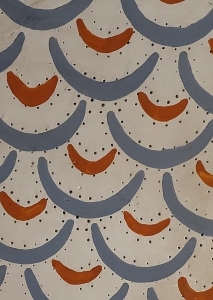Ceilings with perforations in the home of William Morris
THE RED HOUSE in south-east London’s Bexley Heath was the only residence that William Morris (1834-1896) owned, rather than rented. The architect Philip Webb (1831-1915) designed it in a style that resembled that of the Arts and Crafts Movement, which only became prevalent in the last quarter of the 19th century. It was completed in 1860, before Morris began his now famous decorative arts company (in 1861). The house is now maintained by the National Trust, which organises guided tours though its interior. The visitor gets to see art and furniture created by Morris, his wife Jane, Edward Burne-Jones, Dante Gabriel Rossetti, and others associated with the Pre-Raphaelite Movement.

Amongst the many interesting things that the guide pointed out, one feature particularly intrigued me. That is, many of the ceilings in the house can be seen to have numerous tiny holes or perforations. If you look closely, these holes are not random, but are arranged in patterns. These patterns vary from room to room. In the large entrance hallway, which contains a couple of door panels with paintings by Morris, the ceiling is now painted white, but the perforations are arranged in a discernible pattern.
Other ceilings not only have these perforations, but are also covered with colourful hand-painted patterns. Apparently, these were painted by friends of William and Jane Morris. They used to be invited as house guests, fed, and lodged, and then expected to climb on ladders to paint patterns on the ceilings. If you look at these patterned ceilings carefully, you will notice that the painted shapes correspond to the patterns of tiny holes that perforate the ceiling panels. This is no accidental coincidence. Before the ceiling panels were installed, the perforations were made using pieces of wood in which nails had been arranged to create the pattern required for a particular ceiling. The panels were then pressed with these beds of nails to produce the desired pattern on the panels. The perforations helped the painters to create the designs that Morris had chosen for them. Although at first sight, the ceilings look as if the patterns were mass produced, careful examination reveals that the hand painted elements of each design are not precisely identical. The painters probably tried to reproduce the elements of the designs accurately, but being hand-painted rather than mechanically reproduced, tiny differences can be discerned. This is what Morris wanted: his ideal was old-fashioned craftsmanship rather than industrial mass-production.
While showing us the ceiling above the stairwell, our guide pointed out something that Morris might not have wanted. Hidden behind a beam, and quite difficult to see, there is what we now call a ‘smiley face’ instead of an element of the pattern seen on the rest of the ceiling. It might possibly have been put there by one of his unpaid friends, who was getting bored.
The Red House, which is now embedded in the aesthetically unexciting suburban sprawl of south-east London, was once in open countryside. It is well worth visiting this place, which is one of the earliest examples of what was later to become known as the Arts and Crafts style, but you do need to book your tour in advance.



